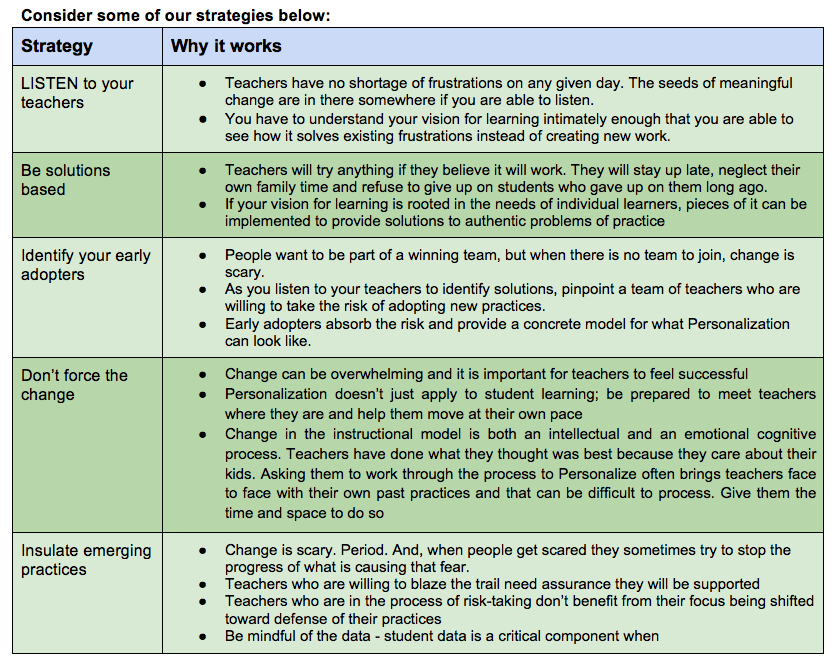Personalized Learning: From Tech Equity to Pedagogical Evolutionby Kristi Levy, ASCD Teacher Impact Grant recipient, Oshkosh Area School District Welcome to the (r)Evolution?From the U.S. Department of Education to the Future Ready Schools framework, professional journals, conference session guides, blogs, tweets and more memes than you can shake a stick at -- Personalized Learning is a phrase that abounds in nearly every educational context. If you peer beneath the surface of the intriguing titles and inspiring claims to “meet the needs of all learners,” what is being described as the cohesive desire to “personalize” breaks down into an unrecognizable disarray of ideologies and practices. As such, it is not surprising to hear educators and researchers taking sides in the debate over whether or not Personalized Learning is a path to gains for all learners. The further you trace the professional discourse surrounding Personalized Learning into the ether, the more murky the issue becomes and so, the question remains - is Personalized Learning worth it?
Where Did We Begin? - Aligning Visions of LearningEstablishing a vision for learning is a task that districts statewide have been grappling with for decades. We have seen this play out, most recently, in the implementation of standards-based learning and the emphasis on College, Career & Community Readiness. However, districts have often failed to engage some of our most critical stakeholders by not giving our community a seat at the decision-making table. When we talk about CCCR, without the immediate and tangible voice of the community, districts are left to make assumptions about their community’s ask. In recent years, our schools have begun to undergo a massive transformation, not dissimilar to the periods of rapid change the United States witnessed during the shift toward an apprenticeship system during the Agricultural Age and a movement toward a compulsory, modern education to meet the needs of the Industrial Age. Each of these educational paradigms were designed to meet the ask of their respective society (Smith, Chavez, Seaman 2014). However, schools have been slow to transition to the impending Conceptual Age and part of that has been a systemic disconnection between schools and the communities they serve. Inviting the folks from your town to come in for “Community Nights” and sharing your stories of teaching and learning is not the kind of community partnership that will enable meaningful instructional change to happen in order to meet their changing needs. A move toward Personalization needs to be rooted in your community’s ask. What our community needs from our graduates is a critical part of the equation that is too often overlooked and left out when defining what it means to Personalize. As part of our strategic planning process, our community sent the clear message that we needed to provide an environment of technological equity among learners and we needed to be more instructionally agile so that each student is able to progress based on his/her own level of mastery. Not surprisingly, our community stakeholders struggle with an instructional model that assumes 30+ learners need the same support and instruction for the same duration of time. Furthermore, they want employees and community members that are able to learn quickly and independently. As quickly as technology changes, so too does the role of the employee and the community member. With increasing institutional dependence on technology comes the need for members of the institution to be agile and flexible in their ability to audit, evaluate and implement their own learning. It’s not enough to just “do your job” anymore. It simply doesn’t work that way in the modern era. If you learn a programming language, a year or two later, that language will cease to exist or be in a rapid decline (Newman 2016). The move to true Personalization is a pedagogical shift that relies on the examination of our core beliefs about learning, but as importantly, it relies on our understanding of our community needs. In the absence of authentic community engagement, it is not surprising that many districts, nationwide, have missed the target on Personalized Learning. Without the emphasis the community places on learning and student readiness, many definitions tied to Personalized Learning refer merely to access. In such implementations districts go to great lengths to meticulously plan the logistics of a 1:1 technology initiative and, once students’ have access to a personal device, educators rejoice at how “personalized” the learning experience has become. While access has certain undeniable benefits for students, it does nothing to change the learning experience or meet individual learners’ needs. The act of adding 1:1 technology to the environment is, in and of itself, a transactional change. It is the technological equivalent of putting all students and teachers on the same starting line, but it will not redefine teaching and learning. Personalization in Practice
With a greater understanding of our key components, teachers have begun to revisit and re-ground themselves in crucial instructional practices. They are asking questions such as, “If Pacing is based on mastery, how are students moving through the curriculum and where do they start?” And, “If students are able to shape the learning experience, how does this change my role as a teacher?” These questions have allowed teachers to see the practices we have been working to implement for years in a new, more purposeful, light. Formative assessment suddenly took center stage as teachers began to envision a mastery based learning experience. DuFour’s essential questions, ceased to be “one more thing” to think about and became a critical practice in determining a students’ learning path and where on that path they started. In short order, instructional planning has become a daily process which revolves around student work and student data rather than the unit calendars that could be planned and inked to account for weeks, even months, of instruction.
Standards-Based Learning as the Foundation of Personalization
Teachers as the Drivers of Instructional ChangeTake a moment to think about one of the most meaningful changes to teaching and learning that has happened in your building or district. Chances are, that change came from classroom teachers. On the contrary, think of an instructional shift that failed -- where did that shift originate? In some cases those shifts came from the state and in others they may have come from the top down in your own district. And, odds are, they didn’t fail to take hold because they were bad ideas. They failed because the wrong people owned them. Whenever possible, instructional change should begin at the level of the practitioner. While this may ring contrary to meeting our community’s ask, the two are not mutually exclusive. So, how does your community’s ask become a grassroots instructional change?
Personalized Learning - Is It Worth It?While professional educators come at Personalized Learning from all angles, we continue to listen to the noise of the discourse. As we have developed our vision of what Personalization looks like we have acknowledged that every voice matters. But, ultimately we come back to this -- if Personalization is rooted in student learning and focused on the evidence of such learning, it is a move in the right direction. Our practices in Personalization are emerging and we continue to learn and grow, but the initial results are promising. Our work toward Personalization has begun to operationalize our collective sentiment that when we say all learners, we mean ALL. The future holds many new challenges for our cohort. There will be days of data digs, adjusting, last minute changes and lots and lots of troubleshooting. But, there are also days when students show us products of their learning we could never have conceived of, talents that were buried by the academia of a traditional school day and academic and emotional growth that only comes when students are at the helm. In short, I am not telling you it has been easy, but it has been worth it. References Newman, Daniel. "In The Digital Age, Employees Must Be More Agile Than Ever." Forbes Magazine 15 Mar. 2016. Web. 19 Oct. 2016. Smith, Shawn K., Ann M. Chavez, and Garret W. Seaman. Teacher as Architect. 2nd ed. N.p.: Modern Teacher Press, 2014. N. pag. Print. Special contributions made by: Heather Kangas - Instructional Support Teacher for Curriculum & Assessment - Oshkosh West High School. Malary Hill - Grade 9 English Teacher and PL Cohort member - Oshkosh West High School Alex Griffith - Grade 10 English Teacher and PL Cohort member - Oshkosh West High School Will Brydon - Global Academy Teacher and PL Cohort member - Oshkosh West High School |
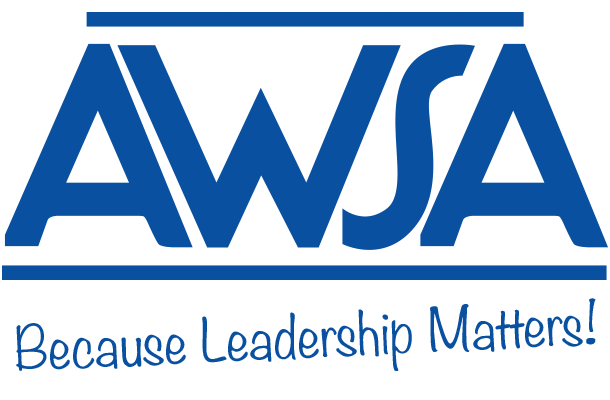
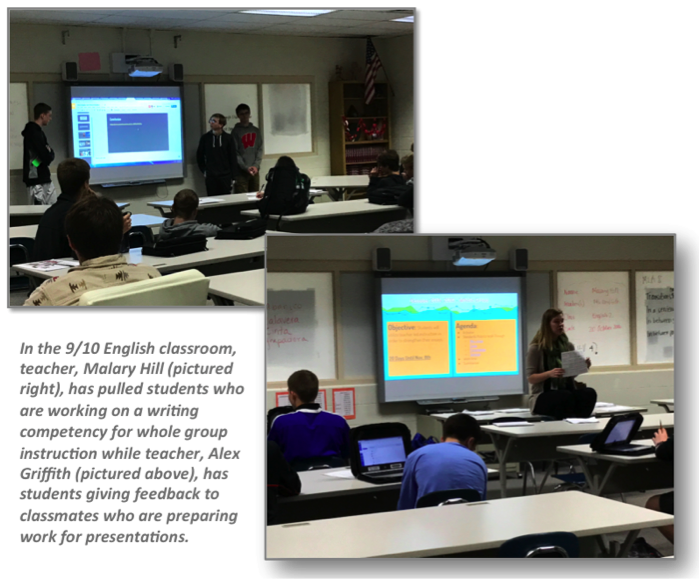 As the bell rings for 3rd hour to begin, 62 students (in grades 9 and 10) and 3 teachers pour through the doors of the large, double classroom. The demographics of this class consist of English language learners, special education students, regular education students, at-risk students and what our teachers affectionately refer to as “honors dodgers”. Today, and most days, students are moving between small group workshops facilitated by teachers, supported independent work and collaborative group work with their peers. Whole group direct instruction is visible, but based on need and students are working on a variety of competency-based targets based on their learning needs and mastery level while teachers are engaging in a variety of instructional tasks. This scene will not be foreign to many secondary teachers, but this room is not home to credit recovery or intervention. This is not a glimpse into a “learning lab” or a special program -- this is a glimpse into Learning. The teachers in this classroom are part of a cohort of high school teachers who are challenging the traditional paradigm of the high school classroom, and, they are doing it through Personalized Learning.
As the bell rings for 3rd hour to begin, 62 students (in grades 9 and 10) and 3 teachers pour through the doors of the large, double classroom. The demographics of this class consist of English language learners, special education students, regular education students, at-risk students and what our teachers affectionately refer to as “honors dodgers”. Today, and most days, students are moving between small group workshops facilitated by teachers, supported independent work and collaborative group work with their peers. Whole group direct instruction is visible, but based on need and students are working on a variety of competency-based targets based on their learning needs and mastery level while teachers are engaging in a variety of instructional tasks. This scene will not be foreign to many secondary teachers, but this room is not home to credit recovery or intervention. This is not a glimpse into a “learning lab” or a special program -- this is a glimpse into Learning. The teachers in this classroom are part of a cohort of high school teachers who are challenging the traditional paradigm of the high school classroom, and, they are doing it through Personalized Learning.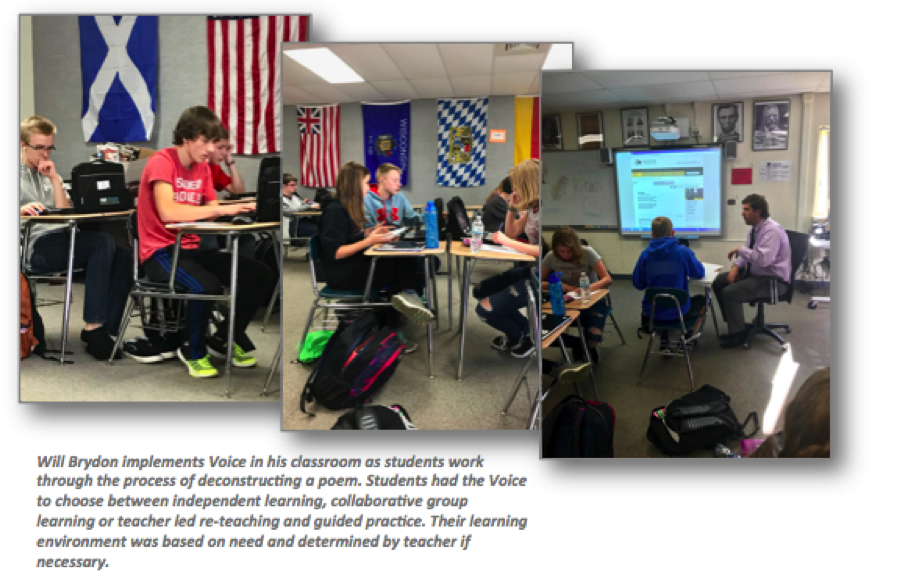 All of this begs the question -- if Personalized Learning is not about access to technology, what is it? At its heart, Personalized Learning is about meeting the needs of every learner. This means meeting students’ learning needs, but also engaging learners by addressing their social/emotional needs, allowing room for their curiosity and creativity and honoring their level of mastery while simultaneously addressing their needs for growth. For districts, this means using data from strategic community planning sessions to narrow down a definition of what, exactly, it means to Personalize learning for our students. After sifting through the comments and responses it was evident that the heart of our community’s ask was the desire for students’ to have Voice, Choice and Pacing options. The next step was to further define the components:
All of this begs the question -- if Personalized Learning is not about access to technology, what is it? At its heart, Personalized Learning is about meeting the needs of every learner. This means meeting students’ learning needs, but also engaging learners by addressing their social/emotional needs, allowing room for their curiosity and creativity and honoring their level of mastery while simultaneously addressing their needs for growth. For districts, this means using data from strategic community planning sessions to narrow down a definition of what, exactly, it means to Personalize learning for our students. After sifting through the comments and responses it was evident that the heart of our community’s ask was the desire for students’ to have Voice, Choice and Pacing options. The next step was to further define the components: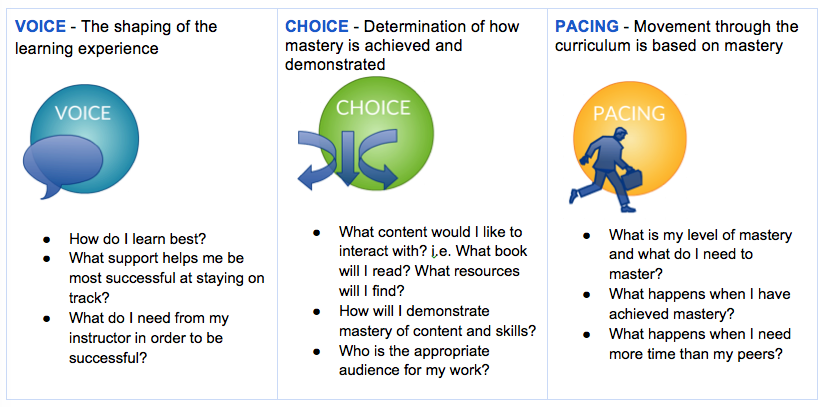
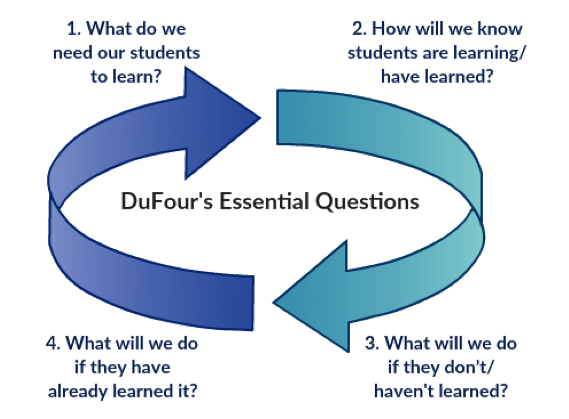 As teachers’ start to play out all of the variables Pacing options present, the process necessitates attention to student Voice. Teachers begin to move into the “how” of students both being able to and being responsible for the shaping of their own learning experience. When student Voice takes on a vital role in the classroom, the role of the teacher, inevitably, shifts. Instruction set at the pace of individual mastery and shaped to meet individual needs, precludes the daily use of whole group, direct instruction. In a student-driven model, whole group direct instruction becomes a conscious choice that is rooted in meeting learners needs rather than the default methodology. One can easily see how all of these factors combine to provide a definition of Personalized Learning that relies on students’ access to technology, but is not about access to technology. Personalized Learning as a learning paradigm, transcends any pedagogical shifts that revolve around technology tools.
As teachers’ start to play out all of the variables Pacing options present, the process necessitates attention to student Voice. Teachers begin to move into the “how” of students both being able to and being responsible for the shaping of their own learning experience. When student Voice takes on a vital role in the classroom, the role of the teacher, inevitably, shifts. Instruction set at the pace of individual mastery and shaped to meet individual needs, precludes the daily use of whole group, direct instruction. In a student-driven model, whole group direct instruction becomes a conscious choice that is rooted in meeting learners needs rather than the default methodology. One can easily see how all of these factors combine to provide a definition of Personalized Learning that relies on students’ access to technology, but is not about access to technology. Personalized Learning as a learning paradigm, transcends any pedagogical shifts that revolve around technology tools.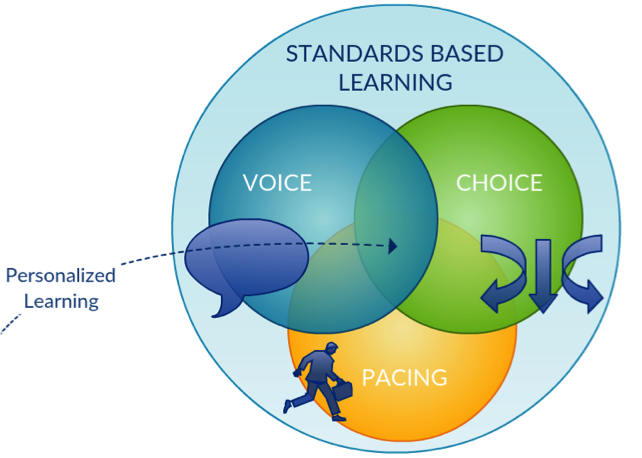 As instructional leaders, we are all too familiar with the perceptual challenges associated with a “one more thing” or “another new thing” culture of teaching and learning. As we think about ways in which we have asked teachers to think differently about their craft in order to be responsive to students needs, we quite easily see them as part of a larger and more cohesive vision of best practice. However, it is not uncommon for our teachers to feel like we are asking them to do “one more thing” or “another new thing” as if we are pivoting away from existing practices. To the contrary, at the foundation of our work, there is only ONE thing -- student learning. Under this singular umbrella of student learning, resides a variety of best practices and standards-based learning is the foundation. Personalization is not a move away from a standards-based curriculum, but rather, a standards-based curriculum is a critical foundation for true Personalization. In order to operationalize the implementation of Voice, Choice and Pacing options, students must be as familiar with the standards and learning targets as their teachers are. With a new, more applied, understanding of the role standards play in the learning process, teachers and students are able to partner in a way that allows students to become instructional designers. Not only are we not leaving a standards-based learning model, Personalization actually puts the standards at the forefront of classroom as students become increasingly engaged with the learning targets and move away from teacher designed assignments and activities.
As instructional leaders, we are all too familiar with the perceptual challenges associated with a “one more thing” or “another new thing” culture of teaching and learning. As we think about ways in which we have asked teachers to think differently about their craft in order to be responsive to students needs, we quite easily see them as part of a larger and more cohesive vision of best practice. However, it is not uncommon for our teachers to feel like we are asking them to do “one more thing” or “another new thing” as if we are pivoting away from existing practices. To the contrary, at the foundation of our work, there is only ONE thing -- student learning. Under this singular umbrella of student learning, resides a variety of best practices and standards-based learning is the foundation. Personalization is not a move away from a standards-based curriculum, but rather, a standards-based curriculum is a critical foundation for true Personalization. In order to operationalize the implementation of Voice, Choice and Pacing options, students must be as familiar with the standards and learning targets as their teachers are. With a new, more applied, understanding of the role standards play in the learning process, teachers and students are able to partner in a way that allows students to become instructional designers. Not only are we not leaving a standards-based learning model, Personalization actually puts the standards at the forefront of classroom as students become increasingly engaged with the learning targets and move away from teacher designed assignments and activities.